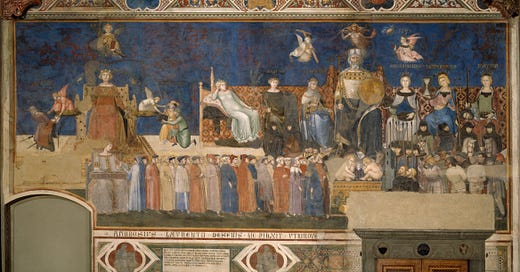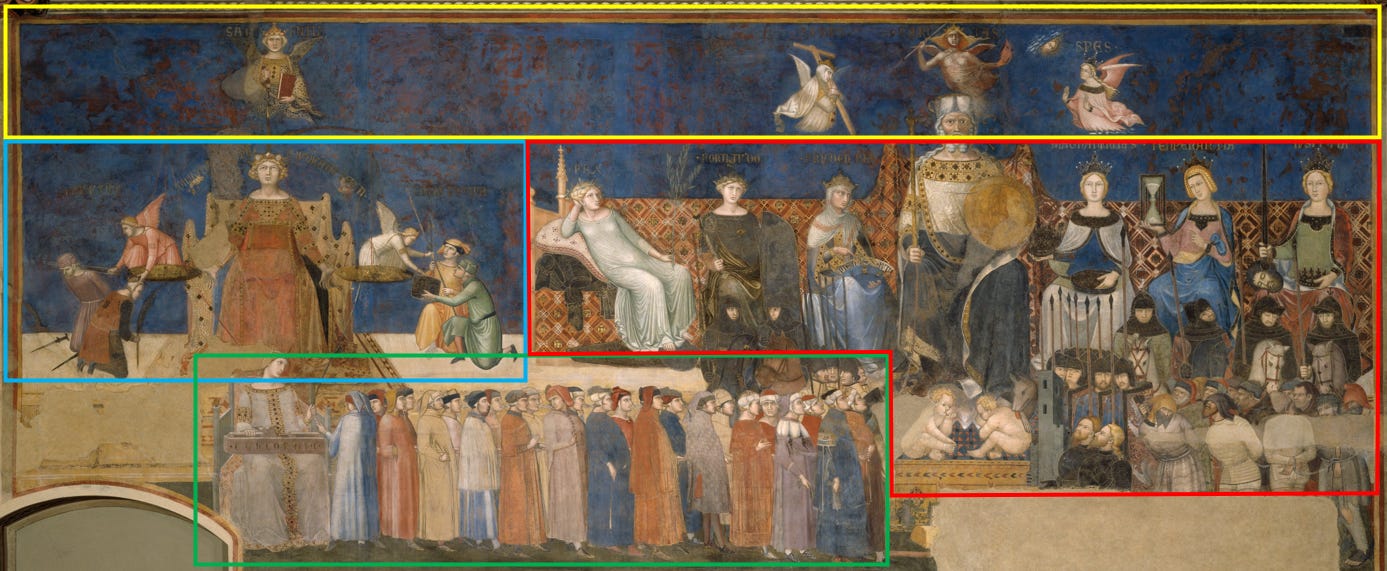'The Allegory of Good and Bad Government' (A. Lorenzetti): Why these 700-year-old fresco panels are more relevant than ever (part 2)
What is a "good" government?
This is the second part from a series about ‘The Allegory of Good and Bad Government’ by Ambrogio Lorenzetti. Part 1, which covers the political context in Siena, is available here. Part 3 will be available next week.
After having explored the general context behind the panels, I will now focus on the most important one: the central panel from which the other two emerge: ‘The Allegory of Good Government’.
General Composition
The primary aim of the work is informative, presenting the essential values for establishing an effective governance in the city. The painting becomes political through the development of a new theoretical dimension for the time, made of allegories and personifications. Concrete ideas become concepts and ideals, which in turn are meant to influence the decisions of the Siena’s councilors and the city's broader culture.
The organization of the painting can be divided into four main areas:
(red) The Republic of Siena is represented by an old man dressed in the traditional colors of Siena - black and white. He holds a rope in his right hand, symbolizing a connection with the other parts of the painting;
(blue) The Allegory of Justice is seated under Wisdom, positioned between the two scales of balance. A white angel holds a rope connected to the personification of Siena;
(green) Concordia holds the rope and a plane, smoothing out arguments. In the procession next to her, people of various social roles - as signified by their attire - are all the same height, emphasizing the idea of unity through concord. The citizens of Siena, depicted in the procession, hold the rope that links the ruler to Justice via Concordia;
(yellow) The sky, with angels floating above, defines the relationship with God. One angel (SAPENTIA - “Wisdom”) guide justice; the three other (FIDES, CARITAS and SPES - “Faith, Charity and Hope”) guide the Siena administration.
Let’s go deeper and have a look, from left to right, to the details of the painting.
It is all about Justice
On the left side, the least populated part of the painting, Justice is seated. The figure is easily identifiable by the scales, her traditional symbol.
In the sky above Justice, we observe “SAPENTIA” (“Wisdom”), holding the scourge of Justice in one hand and a book, probably the Book of Wisdom, in the other. As said, the sky symbolizes the connection between the divine and the human realms, and human justice must be inspired by divine wisdom.
Above the head of Justice, the inscription reads: “DILIGITE IVSTITIAM QUI IVDICATIS TERRAM”, which is actually the incipit of the Book of Wisdom which translates as “Love righteousness, you rulers of the earth”. The connection between God's wisdom and earthly justice is made explicit here.
This is also one of several references to Simone Martini’s ‘Maestà’, located in the same building, where the same text appears on the parchment held by the child Jesus.
Two small scenes on either side of Justice’s scales represent the two essential aspects of an effective justice system.
On the left, “DISTRIBUTIVA” (“distributive justice”) is depicted, addressing punishment and exoneration. Society is unequal, with good and bad individuals requiring different treatment based on their actions. One scene shows a criminal (his sword cast aside) about to be beheaded, while another figure is being crowned. The harshness of the punishment reinforces the notion that Justice must be merciless toward wrongdoers to maintain credibility.
On the right, “COMUTATIVA” (“commutative justice”) regulates trade and commerce, a crucial function in a merchant city like Siena.
Justice is undoubtedly the most important figure in the painting, emphasized by Lorenzetti as she is depicted twice - once in a dedicated section. There can be no peace without justice.
Concordia to Equal Them All
To reinforce the theme, two ropes held by angels converge in Concordia’s hand. A fair Justice fosters Concord, which in turn leads to unity.
Concord is both the result of fair justice and the principle that ensures its practice. The spirit of concord binds citizens together, encouraging everyone to work towards a common goal. The female figure of Concordia holds a large plane on her lap, symbolizing the equalization of all. The twenty-four men in the procession next to her are the same height despite their different social roles, illustrating that civic unity comes from equitable treatment.
This harmony creates the necessary conditions for an organized society, linking (through the rope) Justice to the Old Man, who represents the Republic of Siena - a human construction guided by divine values.
A Stable and Peaceful Republic
Now that Siena has both Justice and Concord, the city needs good governance to ensure these principles flourish and guide its citizens toward prosperity. The Old Man, representing the Republic of Siena, holds the rope brought by the procession of equal citizens.
The Old Man symbolizes good governance, surrounded by nine virtues: the four cardinal virtues (Prudence, Justice, Fortitude, and Temperance), the three theological virtues (Faith, Hope, and Charity), along with Magnanimity and Peace. These virtues represent the governing body of the Nine.
Four distinct elements highlight the personification of Siena in the figure of the Old Man:
His tunic made of two horizontal black and white bands, the colors of Siena;
The letters “CSCV” around his head, meaning Comune Senarum Civitas Virginis (Commune of Siena, City of the Virgin);
He holds a shield bearing Siena’s municipal seal, depicting the Madonna and Child flanked by two angels;
The Sienese she-wolf, a reference to the city's mythological founders, Senius and Aschius. Sons of Remus, they fled Rome, one on a white horse and the other on a black horse, after the assassination of their father by Romulus and founded the city of Siena.
The three virtues in the sky, which define the relationship between the world of men and God, are theological: “FIDES” (“faith”) carrying a cross, “CARITAS” (“charity”) holding a heart in his hand, “SPES” (“hope”) admiring the face of God.
These virtues are granted by God himself and complete the four cardinal virtues seated with the Old Man, which were described by Greek philosophers.
These four virtues are also mentioned in the Book of Wisdom (8.7): “And if any one loves righteousness, her labours are virtues; for she teaches temperance and prudence, justice and fortitude; nothing in life is more profitable for men than these.”
All combined, they are called the seven heavenly virtues in the Christian tradition.
As the attentive reader may have noticed, Justice appears twice - highlighting her importance in Lorenzetti’s vision.
Temperance and Justice are accompanied with Magnanimity. But the most interesting thing is the crowd gathering beneath these virtues.
Soldiers protect the city and its values, maintaining order and ensuring the proper functioning of the government. Some of these figures are chained prisoners, representing the consequences of upholding these principles.
Beside a castle, two armored men kneel before the Old Man - lords swearing allegiance to Siena, a testament to the city's influence and power.
To the right of the Old Man are the virtues of “PAX” (“Peace”), “FORTITUDO” (“'Fortitude”), “PRUDENTIA” (“Prudence”).
Peace, distinct from the other virtues, is crowned with an olive branch and depicted in a relaxed pose, her white robes contrasting with the rigidity of the others.
Peace is not a prerequisite for good governance but its consequence. She is serene, aware that she resides in a well-governed city, thanks to the firmness of the other virtues. She gazes toward the eastern wall, hinting at the continuation of this story in the next panel: ‘The Effects of Good Governance in the City and in the Countryside’.
But that’s a discussion for next week!

















